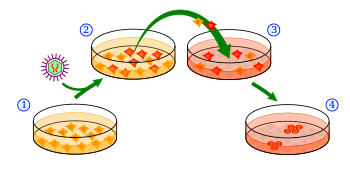خلية جذعية محرضة متعددة القدرات
خلية جذعية مـُحرَّضة متعددة القدرات هي نوع من الخلايا الجذعية، يتم اشتقاقه اصطناعيًا من خلايا غير متعددة القدرات، عادة من خلايا جسدية بالغة، عن طريق إجبارها على تعبير جينات خاصة.
تشبه الخلايا الجذعية المحرضة متعددة القدرات الخلايا الجذعية متعددة القدرات في العديد من الجوانب، مثل الخلايا الجذعية الجنينية، مثل تعبير جينات وبروتينات خاصة بالخلايا الجذعية، زمن التضاعف، تشكيل أجسام مضغية الشكل وتشكيل الأورام المسخية.
انتاج iPSCs

Dedifferentiation to totipotency or pluripotency: an overview of methods. Various methods exist to revert adult somatic cells to pluripotency or totipotency. In the case of totipotency, reprogramming is mediated through a mature metaphase II oocyte as in somatic cell nuclear transfer (Wilmut et al., 1997). Recent work has demonstrated the feasibility of enucleated zygotes or early blastomeres chemically arrested during mitosis, such that nuclear envelope break down occurs, to support reprogramming to totipotency in a process called chromosome transfer (Egli and Eggan, 2010). Direct reprogramming methods support reversion to pluripotency; though, vehicles and biotypes vary considerably in efficiencies (Takahashi and Yamanaka, 2006). Viral-mediated transduction robustly supports dedifferentiation to pluripotency through retroviral or DNA-viral routes but carries the onus of insertional inactivation. Additionally, epigenetic reprogramming by enforced expression of OSKM through DNA routes exists such as plasmid DNA, minicircles, transposons, episomes and DNA mulicistronic construct targeting by homologous recombination has also been demonstrated; however, these methods suffer from the burden to potentially alter the recipient genome by gene insertion (Ho et al., 2010). While protein-mediated transduction supports reprogramming adult cells to pluripotency, the method is cumbersome and requires recombinant protein expression and purification expertise, and reprograms albeit at very low frequencies (Kim et al., 2009). A major obstacle of using RNA for reprogramming is its lability and that single-stranded RNA biotypes trigger innate antiviral defense pathways such as interferon and NF-κB-dependent pathways. In vitro transcribed RNA, containing stabilizing modifications such as 5-methylguanosine capping or substituted ribonucleobases, e.g. pseudouracil, is 35-fold more efficient than viral transduction and has the additional benefit of not altering the somatic genome (Warren et al., 2010). An overarching goal of reprogramming methods is to replace genes with small molecules to assist in reprogramming. No cocktail has been identified to completely reprogram adult cells to totipotency or pluripotency, but many examples exist that improve the overall efficiency of the process and can supplant one or more genes by direct reprogramming routes (Feng et al., 2009; Zhu et al., 2010).

A scheme of the generation of induced pluripotent stern (IPS) cells. (1)Isolate and culture donor cells. (2)Transfect stern cell-associated genes into the cells by viral vectors. Red cells indicate the cells expressing the exogenous genes. (3)Harvest and culture the cells according to ES cell culture, using mitotically inactivated feeder cells (lightgray). (4)A small subset of the transfected cells become iPS cells and generate ES-like colonies.
الهامش
وصلات خارجية
- Center for iPS Cell Research and Application, Kyoto University
- Takahashi, Kazutoshi; Tanabe, Koji; Ohnuki, Mari; Narita, Megumi; Ichisaka, Tomoko; Tomoda, Kiichiro; Yamanaka, Shinya (2007). "Induction of Pluripotent Stem Cells from Adult Human Fibroblasts by Defined Factors". Cell. 131 (5): 861–872. doi:10.1016/j.cell.2007.11.019. PMID 18035408.
- Takahashi, Kazutoshi; Yamanaka, Shinya (2006). "Induction of Pluripotent Stem Cells from Mouse Embryonic and Adult Fibroblast Cultures by Defined Factors". Cell. 126 (4): 663–676. doi:10.1016/j.cell.2006.07.024. PMID 16904174.
- With few factors, adult cells take on character of embryonic stem cells
- Kyoto University's news ( Japanese )
- Generating iPS Cells from MEFS through Forced Expression of Sox-2, Oct-4, c-Myc, and Klf4
- 2 Minute Video from BSCRF about Induced Pluripotent Stem Cells
- 20Minute Video / The Discovery and Future of Induced Pluripotent Stem (iPS) Cells by Dr. Yamanaka January 8, 2008
- A blog focusing specifically on iPS cells and research, biotech, and patient-oriented issues
- Fact sheet on reprogramming
- Insertech on stem cells
- iPS from single human hair follicles
- Human induced pluripotent stem cells—from mechanisms to clinical applications.